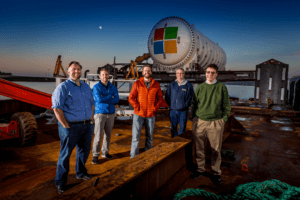The pod was fully loaded with equipment able to measure underwater pressure, humidity and motion.
The long-term plan was that similar capsules would be linked to one another in a chain, beneath the surface and they would use the movement of the seawater to generate energy.
The Leona Philpot was taken out of the water in 2016 and its successor, Project Natick, has already been submerged near the Orkney Islands in Scotland and is processing workloads with 12 racks of 864 servers.
Thanks to the ocean’s naturally low temperatures at certain depths, most of the usual costs that come with such a project have been eliminated.

Microsoft’s Project Natick team
In the next 12 months, the team will be monitoring the performance of the data center, even if it has been designed to operate for over 5 years without the need for maintenance.
Microsoft’s vision concerning Project Natick is one of sustainable data centers that operate solely from the seafloor, as the demand for cloud computing infrastructure is ever growing.
Follow TechTheLead on Google News to get the news first.





















